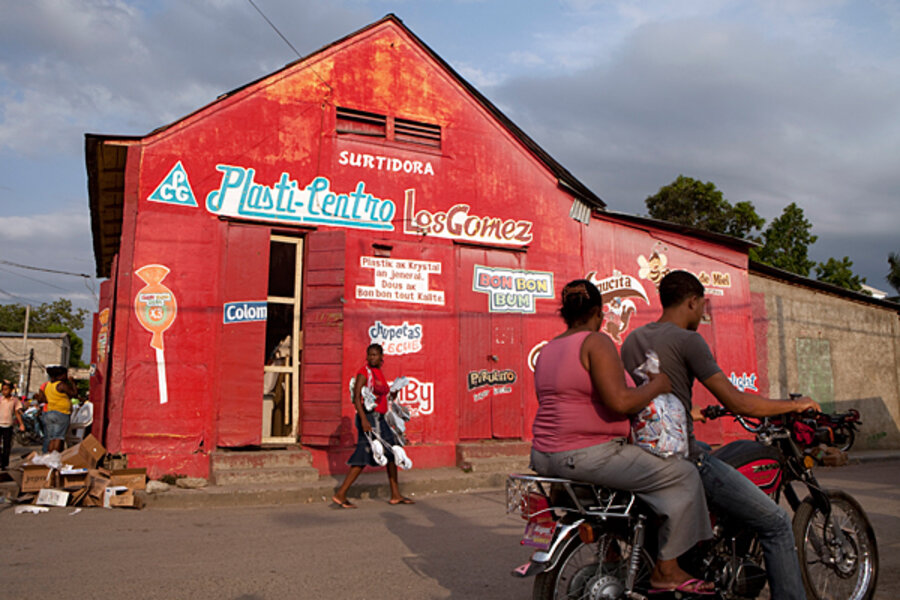Haitians, Dominicans try to move beyond Parsley Massacre's long shadow
Loading...
| Dajabón, Dominican Republic
In the long-strained relationship between Haiti and the Dominican Republic, perhaps the darkest moment took place near this border town in October 1937. Dictator Rafael Trujillo ordered the killings of thousands of Haitians, whose bodies were dumped in the aptly named Massacre River that separates the two countries.
Seventy-five years have passed since the so-called Parsley Massacre killed upwards of 12,000 Haitians and Dominicans who tried to come to their aid. Yet in spite of its importance, the massacre was largely forgotten, not discussed or taught in Haiti and widely misinterpreted in the Dominican Republic. Scholars and activists, however, say its effects lived on, forever changing the relationship between Haitians and Dominicans, neighbors on the Caribbean island of Hispaniola.
Last week, however, led by members of the Haitian and Dominican diasporas living in the US, hundreds of people gathered along the border to recall the massacre and address its legacy. The three-day Border of Lights initiative was highlighted by a vigil in which hundreds of Dominicans and Haitians met on opposing sides of the river and sent candles adrift in its shallow waters.
“None of our governments have paused for a moment of silence in 75 years to say that this was a sad and painful chapter in our history and we have to learn from it in our daily dealings as a state, and as part of a total island,” says Edwidge Danticat, an acclaimed Haitian author who helped organize the event.
“It's important to reflect on both sides of the border what this history means in terms of our dealings from now on,” Ms. Danticat says, “how we see each other as island neighbors, consumers and producers, and in some cases as binational family members and generally as human beings.”
‘Institutionalized’ anti-Haiti sentiment
Prior to the massacre, Haiti and the Dominican Republic enjoyed years of good relations. Removed from the power centers of Santo Domingo and Port-au-Prince, the border was peaceful and fluid.
That changed, however, over five days in early October 1937 when, acting on President Trujillo’s orders, soldiers killed thousands with machetes, bayonets, and rifles. Trujillo's exact reason remains unknown, although historians have speculated it was part of his effort to control the border and "whiten" the country.
It earned the moniker Parsley Massacre because some soldiers carried a parsley sprig and asked suspected Haitians to pronounce the Spanish word for it, perejil. Mispronunciation of the “R” in the word – difficult for native creole speakers – was enough to get you killed.
After the massacre, Trujillo commissioned papers that sought to justify the killings by highlighting the 22-year Haitian occupation of the Dominican Republic – which had ended more than a century earlier – and stirred up fears that Haitians were trying to overrun its neighbor.
The historical tensions between the countries are still apparent. Each year, Dominicans celebrate independence from Haiti as well as Spain, despite winning independence from the European colonists most recently.
“The legacy [of the massacre] was to reverse the long period of peaceful relations between the countries that had existed in the years before the massacre,” says Michele Wucker, whose 1999 book “Why the Cocks Fight” examines Haitian-Dominican relations.
The tragedy marked the start of “institutionalized” anti-Haitian policies within the Dominican government, says Edward Paulino, a Dominican-American history professor at the City University of New York (CUNY) who helped organize the commemoration.
“It’s not true that this anti-Haitianism that you see today is timeless,” he says. “Much of it began with the massacre in 1937.”
Mr. Paulino points to current government policies, such as the change in law that has deemed Dominicans of Haitian descent as foreigners rather than citizens, despite being born in the country. Under those laws, hundreds of people have been stripped of their documentation, leaving a group of functionally stateless people, human rights groups say.
Solidarity
There was another side of the massacre, however, says Edwin Paraison, executive director of Santo Domingo-based Fundación Zile, a nongovernmental organization that works on Haitian-Dominican relations.
“From this painful episode … was born the solidarity between Dominicans and Haitians that still exists,” he says, mentioning that many Dominicans lost their lives in the massacre while trying to protect Haitian victims.
Mr. Paraison was the minister of Haitians living abroad when the January 2010 earthquake destroyed his country. “The Dominicans were the first to respond to lend support and aid to Haiti,” Paraison says. “What’s important here is to rescue and highlight the solidarity between Dominicans and Haitians.”
That solidarity, he says, was on full display last week during the commemoration of the massacre. “You have people from both Haiti and the Dominican Republic, notable people, artists, authors, who are recalling an event 75 years later that affected both countries. That demonstrates solidarity.”







